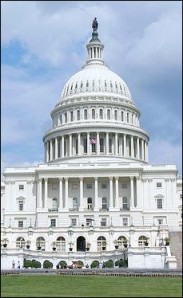Even this early in an election cycle, some obvious 2014 targets are evident. In the Senate, majority Democrats must protect 20 seats versus 13 for Republicans. The GOP will need to convert six Democratic states in order to re-capture the majority for the first time since 2006.
In the House, it’s much too early to tell how the cycle will even begin to unfold, but the 2012 winners who scored at or below 50 percent normally find themselves in vulnerable situations two years later. There are 20 winners who scored a bare majority or less in their win last month.
Here’s how we see things lining up:
The Senate
Already, there appear to be four potential toss-up campaigns on the horizon at the very beginning of the election cycle.
Two states already have announced challengers to Democratic incumbents that many believe are headed for retirement despite the senators themselves saying they are planning a re-election campaign.
• West Virginia Rep. Shelley Moore Capito (R-WV-2) officially announced that she will challenge five-term Sen. Jay Rockefeller (D) in the next election. With West Virginia now trending deep red and Rockefeller launching verbal attacks against the state’s dominant coal industry, this race must be cast as an early toss-up. Should Rockefeller — who will be 77 years old at the time of the next election — not seek another term, Capito will be considered the early favorite.
• Former South Dakota Gov. Mike Rounds (R) also has announced that he will run for the Senate in 2014. He will challenge three-term Sen. Tim Johnson (D). Rep. Kristi Noem (R-SD-AL), who was just re-elected to a second term, also has not ruled out a Senate run, meaning that she would first have to challenge Rounds in the Republican primary. Publicly, she is not closing the door on any 2014 option. A Johnson-Rounds campaign would also have to be rated as an early toss-up. The senator would be favored against Rep. Noem.
• Alaska Sen. Mark Begich (D) stands for a second term after defeating veteran Sen. Ted Stevens (R) by a slim 48-47 percent count in 2008. Stevens was fighting a Justice Department legal onslaught that fell apart on the prosecutors but only after Stevens had already lost to Begich. As you know, the senator was later killed in an airplane crash. This campaign will be interesting. A strong challenger such as Gov. Sean Parnell (R), could make this a very tight campaign.
• Considering that North Carolina was only one of two states that switched from supporting Pres. Barack Obama in 2008 to Mitt Romney last month, freshman Sen. Kay Hagan (D) will seek a second term and be rated in a toss-up campaign from Day One. There is no clear challenger on the horizon, but whomever the Republicans choose will be a serious contender.
The 2014 election cycle will be a long one, but count on these four Senate races grabbing a major share of the political attention for the next two years.
The House
Here’s a look at the 20 winners in 2012 who are right at or a bit below the 50 percent mark who could be vulnerable:
Below 50 percent
- Rodney Davis (R-IL-13) – 47% (open seat)
- Kyrsten Sinema (D-AZ-9) – 48% (open seat)
- John Tierney (D-MA-6) – 48% (incumbent)
- Dan Benishek (R-MI-1) – 48% (incumbent)
- Dan Maffei (D-NY-24) – 48% (challenger)
- Ann Kirkpatrick (D-AZ-1) – 49% (open seat)
- Mike Coffman (R-CO-6) – 49% (incumbent)
- Jackie Walorski (R-IN-2) – 49% (open seat)
- Jim Matheson (D-UT-4) – 49% (incumbent)
At 50%
- Ron Barber (D-AZ-2) – (incumbent)
- Scott Peters (D-CA-52) – (challenger)
- * Patrick Murphy (D-FL-18) – (challenger)
- Dan Schneider (D-IL-10) – (challenger)
- Joe Heck (R-NV-3) – (incumbent)
- Steven Horsford (D-NV-4) – (open seat)
- Carol Shea-Porter (D-NH-1) – (challenger)
- Annie Kuster (D-NH-2) – (challenger)
- Bill Owens (D-NY-21) – (incumbent)
- Mike McIntyre (D-NC-7) – (incumbent)
- * Pete Gallego (D-TX-23) – (challenger)
* Italics: Seat will likely be re-drawn in 2013 redistricting.


